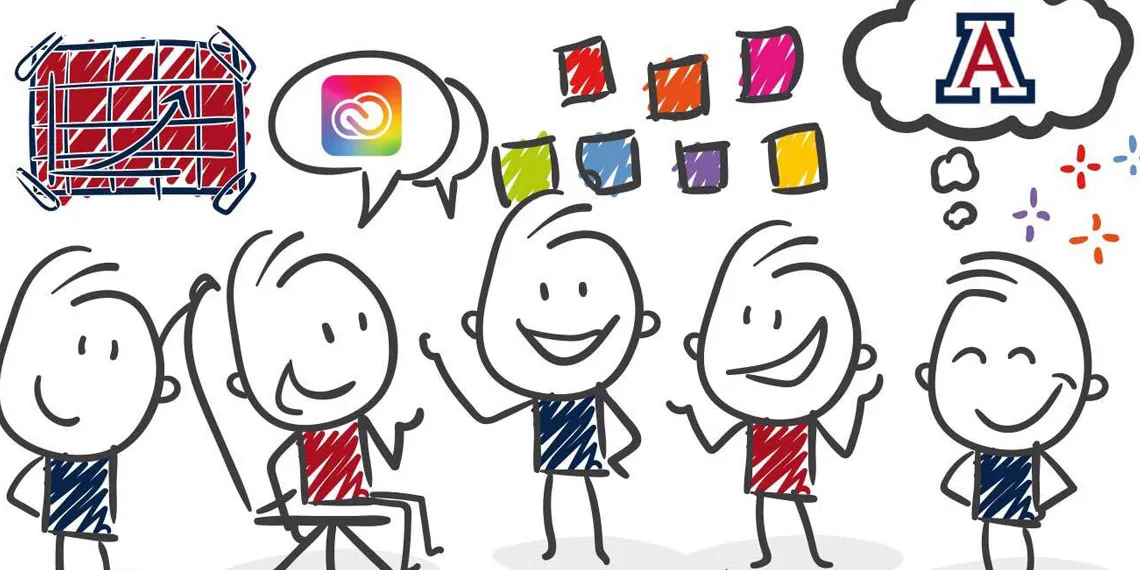Creative Community Building with Adobe & Arizona
We have partnered with Adobe to launch the first university-based professional development program tailored for instructors at the University of Arizona.

In 2017, the University of Arizona became the first Adobe Creative Campus in the West. This fall, Adobe & Arizona claimed another nationwide first when it partnered with Adobe to launch the first university-based professional development program tailored for instructors. Adobe & Arizona’s new Faculty Development Institute supports instructors as they explore Adobe Creative Cloud and develop new course content and assignments that transform the student experience in their class.
"The main idea was to get these software sets into classrooms by having instructors know what they are and what they do," said Brian Puente, who spearheads the Adobe & Arizona program and led the creation of the Faculty Development Institute (FDI).
The idea for the FDI was sparked when Puente heard that Adobe was offering a training program this June for instructors at Adobe Creative Campuses around the nation and jumped at the opportunity to participate. While the format was different - Adobe’s program was a one-week crash course in how to use Adobe Creative Cloud (ACC) in the classroom - the goal resonated with Puente. He asked Adobe if he could do an FDI exclusively for the University of Arizona.
"Adobe really didn’t have an answer for that yet - they weren’t thinking about it," he said. "I told them I could partner with them to do it. I worked with Adobe to create ready-to-deploy strategies and then we built our Faculty Development Institute. It's a little bit different in format, but we still foster opportunities to learn, apply, connect and ask questions."
The inaugural cohort of the FDI kicked off on Sept. 2 and runs through Dec. 4. Instructors are introduced to several ACC apps - Portfolio, Spark, Rush, Audition, Illustrator, InDesign and XD - and they choose two to focus on for a project. The self-guided program is designed to allow participants to learn on their own, but it also provides the opportunity to collaborate, engage and develop among other like-minded creatives. No ACC experience was necessary prior to joining the FDI. In fact, before it began, half of the instructors reported that they felt somewhat uncomfortable or not at all comfortable using Adobe software. Puente was thrilled at the diversity of the instructors in the initial cohort, which includes 21 instructors from more than 15 colleges and units across campus.
"Not only do we have people whose classes revolve around using a specific software, but we also have people who want to add multimedia to a course where students aren’t being graded on how good they are at making multimedia," he said.
Charlette Padilla, Associate Professor of Practice in the Retailing and Consumer Science program, said she was one of the instructors with zero knowledge of ACC before she began engaging with Adobe & Arizona training opportunities. However, as the Fashion Minor Coordinator, she is dedicated to finding a way to integrate ACC into the student experience.
"This is a must for fashion," she said. "Photoshop and InDesign are used in the fashion industry so I really want students to learn them and get a taste for them. They need it."
Instructors are experts in their fields, and Puente said a challenge many face in embracing ACC is the feeling that they must also become experts at the software before they start using it in the classroom. That was originally the case for Padilla.
"Sometimes I felt like an imposter," Padilla said. "I teach in a subject I know very well and I worked in the industry, but this [ACC] I didn’t know. Now I tell them to do something and when they ask questions, and I say 'good question, let’s figure it out.'"
That level of comfort is exactly what Puente is hoping his instructors will gain in the FDI. By the end of the program, he wants them to feel confident when assigning tasks that involve software not only because they have a grasp of the software, but also because they know there is a community and a unit on campus available to support them and their students.
"I’m interested in bridging the divide between instructor and software," he said. "I’m hoping we can have a strong curricular shift toward bringing the software into the classroom and prioritizing creative literacy and digital fluency. I think once people try it and find success with it, they become advocates for what we do."
Throughout the semester, instructors in the FDI have the opportunity to join virtual conversations with the members of their cohort, view live streamed and recorded workshops delivered by experts at other universities, and drop in on Adobe & Arizona scheduled office hours for help as they explore, innovate and create. As part of the program, they also complete the Level 1 – Adobe Creative Educator program, which covers what creativity is, why it is important, and how to cultivate and assess creativity in the classroom using ACC tools.
Integrating existing Adobe training into the FDI has the added benefit of getting instructors plugged into Adobe Education Exchange (EdEx), Adobe’s free crowdsourced learning platform and community. As their final deliverable in the program, FDI instructors will share with the EdEx community two lesson plans that they created that use their chosen apps.
"They post their projects themselves so they’ll get feedback from people who use it," Puente said. "It introduces them to a global community, it helps them grow personally and professionally, and it helps the university’s brand."
Brian Johnsrud, PhD, Education Curriculum Strategy Lead at Adobe, is looking forward to seeing the contributions the members of the FDI cohort make on EdEx, where their work will join thousands of other lesson plans and posts.
"We’re unique among tech platforms in that EdEx was developed in the spirit of user generated content," he said.
While EdEx has traditionally featured the work of external contributors, Johnsrud responded to the needs of countless instructors who were rapidly transitioning to remote teaching this spring by starting an initiative to create more materials with a wider application. To achieve that goal, he launched the Adobe Master Teacher program this summer and tapped Puente to join the first cohort, a group of 35 individuals from across the nation from middle school, high school and higher education institutions.
"We asked them to make 10 small digestible instructional strategies, a project or lesson plan, that paint a picture of what to do," Johnsrud said. "We said, imagine the thousand other faculty, instructors and staff who might be teaching this and design something that’s flexible and adaptable and paints a picture of what the topic could be, but also makes clear that you can swap the topic out and this could still work."
While initially tasked with the creation of 10 projects, Johnsrud invited Puente to create an additional 10. His 20 lesson plans can be found among more than 300 resources found on the official Adobe Distance Learning Resources.
"One of the things that was really exciting about working with Brian was the empathy he has for understanding teacher and student needs," Johnsrud said. "In those moments when we were thinking, ‘how can we break this into bite sized chunks?’ You can see that empathy for instructors and students in the materials he made. That real deep empathy only comes from really spending time trying to solve the problems and challenges of your community. His heart and spirit of service were very evident."
The next challenge Puente is excited to tackle is to build a community of creative scholars ready to reimagine course content and curriculum at the University of Arizona. Puente hopes instructors will consider joining the FDI for more than one term to broaden their knowledge of additional apps, or go deeper into their chosen apps and provide support for incoming cohort members with similar interests. While the FDI cohort size is currently limited by Adobe & Arizona having only one staff member, Puente said that in collaboration with a facilitator and experienced instructors, he could easily double the cohort next semester and create specialized and advanced tracks, something Padilla is interested in.
"I like the idea of going back and going deeper," she said. "I would love to. I’m stuck at my comfort level. It would force me to go further out."
Puente said he hopes the initial FDI cohort will consider coming back for more training, but there are also other opportunities for future involvement in Adobe & Arizona.
"I want to tap a number of them for an advisory board to talk about how we can grow Adobe & Arizona and the FDI," he said. "I’m interested in learning what they need so that I can better tailor future development for them."
While the FDI is a new offering this semester, Adobe & Arizona continues to host a full calendar of (now online) workshops and tutorials offered in partnership with the Bookstore, Catalyst Studios and Eller’s Level Up series. Though the training opportunities Adobe & Arizona offers for the general university community have always been highly regarded and well attended, Puente realized that the best way to reach more students was to find them in the classroom. With more instructors utilizing ACC in their courses thanks to the FDI, more students will gain valuable digital and creative literacy skills.
"One of the main reasons why we do this is for students, so that they'll have artifacts that they can use to show skills and launch their professional careers," he said. "I would argue that your average five-page paper doesn’t have much of a life outside of the classroom, but a five-minute video you make can be used as a portfolio piece to demonstrate skills that can get you hired in any professional field."
"Work beats talent every time," he added. "That goes for instructors as well as students. You get good by doing."


